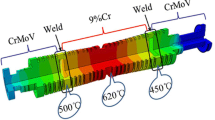Abstract
The influence of operating temperature on in-service degradation of mechanical properties of high temperature stream turbine components has been investigated. Material samples for this study were taken from a Cr-Mo-V rotor and several 2.25Cr-1Mo cast steel components which had operated over 200,000 hours. The test results revealed that the degree of in-service degradation of strength, toughness, and the fracture appearance transition temperature of both steels were very sensitive to the service temperature. Both steels softened only when they were exposed at a temperature greater than 454°C (850°F) and the degree of softening increased with further increase in service temperature. In Cr-Mo-V steel, the loss in strength was accompanied by an improvement in ductility and toughness. Despite softening of 2.25Cr-1Mo steel in service, elevated temperature exposure resulted in a marked decrease in ductility and toughness. The loss of toughness in this steel was in part irreversible. In contrast, a severe increase in fracture appearance transition temperature, due to reversible temper embrittlement, occurred in both steels at a service temperature of around 427°C (800°F), but not at the highest service temperature. In fact, the Cr-Mo-V steel did not temper embrittle as a result of service exposure at the highest operating temperature investigated. These results are rationalized in terms of changes in microstructure and grain boundary chemistry that occur in service as a function of operating temperature.
Similar content being viewed by others
References
R. Viswanathan and A. Joshi:Metall. Trans. A, 1975, vol. 6A, pp. 2289–97.
T. Wada and W.C. Hagel:Metall. Trans. A 1976, vol. 7A, pp. 1419–26.
J. Yu and C.J. McMahon, Jr.:Metall. Trans. A, 1980, vol. 11A, pp. 277–89.
B.J. Brindley and T.C. Lindley:J. Iron and Steel Inst., 1972, vol. 23, pp. 124–25.
Y. Nishizaka, Y. Hara, A. Hori, T. Tsukahara, K. Miyano, T. Wada, and T.B. Cox:ASME Proc. Pressure Vessel Piping Conf., 1985, PVP-vol. 98-1, pp. 125–35.
Z. Qu and K.H. Kuo:Metall. Trans. A, 1981, vol. 12A, pp. 1333–37.
T. Wada and V.A. Bišs:Metall. Trans. A, 1983, vol. 14A, pp. 845–55.
L.H. Toft and R.A. Marsden:JISI & JIM Proc. Intl. Conf. on Structural Process in Creep, 1963, pp. 276–93.
N.S. Cheruvu:ASM Proc. Intl. Conf. on Nuclear Power Plant Aging, Availability Factor and Reliability Analysis, V.S. Goel, ed., 1985, pp. 575–80.
O. Zhe, S.C. Fu, and C.J. McMahon, Jr.:EPRI Report CS2242, Project 559, February 1982.
N.S. Cheruvu, W.E. Howard, and O.M. Beasley:ASME Joint Power Generation Conf., paper #85-JPGC-Pwr-29, 1985.
H.C. Argo and B.B. Seth:Case Studies in Fracture mechanics, Army Materials Research Center, MS77-5, T.P. Rich and D.J. Cartwright, eds., 1977, pp. 3.2.1-11.
Y. Hirota, Y. Kadoya, T. Goto, M. Wake, and H. Fuji:Mitsubishi Heavy Industries Ltd. Technical Review, October 1982.
Supplemental Report onThe elevated Temperature Properties of Cr-Mo Steels, ASTM Data Services Publications No. DS6S1, American Society for Testing and Materials, J.A. Van Etho and W.F. Simmons, eds., 1966, p. 52.
L. Tu and B.B. Seth:Metall. Tech., 1978, vol. 5, pp. 79–91.
R.V. Hart:Metall. Tech., 1976, vol. 3, pp. 1–7.
N.S. Cheruvu and L.R. Malmfeldt:ASME Joint Power Generation Conf., paper #87-JPGC-Pwr-53, 1987.
R. Viswanathan and J.I. Jaffee:Turbine Rotor Life Assessment and Improvement, EEI Prime Movers Committee paper R9, Miami, FL, 1984.
R. Viswanathan:Metall. Tech., 1974, vol. 1, pp. 283–88.
J. Nutting:AIME Proc. Topical Conference of Ferritic Alloys for Use in the Nuclear Energy Technologies, J.W. Davis and D.J. Michel, eds., 1983, pp. 3–16.
J.D. Murray: inPrecipitation process in Steels, ISI Special Report No. 64, 1959, p. 285.
J.D. Baird, A. Jamieson, R.R. Peterson, and R.C. Cochrane:Proc. Conf. on The Creep Strength in Steel and High Temperature Alloys, Sheffield, Metals Society, London, 1973, pp. 207–15.
K.R. Williams and B. Wilshire:Materials Sci. Eng., 1981, vol. 47, pp. 151–60.
K.R. Williams and B. Wilshire:Materials Sci. and Eng., 1977, vol. 28, pp. 289–96.
V.A. Biss and T. Wada:Metall. Trans. A, 1985, vol. 16A, pp. 109–14.
G.C. Gould:American Society for Testing and Materials, Spec. Tech. Publication 407, 1968, pp. 90–105.
R. Viswanathan and T.P. Sherlock:Metall. Trans., 1972, vol. 3, pp. 459–68.
C.J. McMahon, A.K. Cianelli, and H.C. Feng:Metall. Trans. A, 1977, vol. 8A, pp. 1055–61.
Author information
Authors and Affiliations
Rights and permissions
About this article
Cite this article
Cheruvu, N.S. Degradation of mechanical properties of Cr-Mo-V and 2.25Cr-1Mo steel components after long-term service at elevated temperatures. Metall Trans A 20, 87–97 (1989). https://doi.org/10.1007/BF02647496
Received:
Issue Date:
DOI: https://doi.org/10.1007/BF02647496



